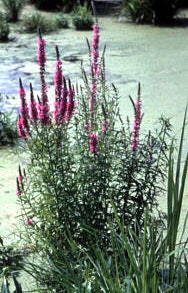Aquatic Invasive Species
Aquatic Invasive Species (AIS) have become a local issue as infestations move toward District counties. The MFCRWD and area lake associations have taken a proactive approach to the issue. One way the District has been proactive is by educating the public on best management practices that will prevent the spread of AIS. You can do your part by making sure to:
- CLEAN – Check your watercraft and trailer for any plants, animals, or mud. Clean your equipment thoroughly by having a professional decontaminate your watercraft and trailer. Adult zebra mussels can survive out of water for up to a month.
- DRAIN – Drain water from bilge, live well, motor, ballast tanks, and portable bait containers, before leaving water accesses or shoreline property. Do not let it flow back into the water body. Veligers (young zebra mussels) can survive in standing water without food up to 27 days.
- DRY – Dry entire boat out in the sun and wind with all hatches open and without covering until completely dry. If you were on an infested water body be safe and call a professional company to decontaminate your watercraft.
- PULL THE PLUG – Drain plugs must be out during transport.
The Watershed District has also been running a watercraft inspection program on public accesses within the District since 2011. Since the start of the program, our interns have inspected 2,332 watercraft. This program has been a great opportunity for our staff to talk with boaters and help them follow all of the laws in Minnesota that pertain to AIS. AIS interns attend Level-1 AIS inspection training conducted by the Department of Natural Resources. Upon completion of this training, MFCRWD AIS Inspectors are authorized to educate boaters about AIS laws, inspect various types of watercraft, and deny lake access to those in violation of the law.
Starry Stonewort (Nitellopsis obtusa) is a bushy, bright green macro-algae. This grass-like algae can be distinguished from others by the presence of star-shaped bulbils. These macro-algae may form a dense mat of materials in shallow areas in bodies of water. Starry Stonewort is a macro-algae, meaning it lacks a vascular system like true plants. Each branchlet, or stem, is a single cell. Meaning when treating these algae, whatever base used must make direct contact with each of these individual cells. Starry Stonewort is primarily spread through the movement of water-related equipment. Fragments can get tangled in trailers, motors, anchors and inside watercrafts (including boats, jet skis, canoes and kayaks). Small bulbils hidden in mud and debris can stick to trailer bunks, anchors, ropes, fabric, footwear, as well as scuba, fishing and hunting gear.
Help prevent Starry Stonewort by cleaning watercraft of all aquatic plants and invasive species, drain all water by removing drain plugs and keeping them out during transport, dispose of unwanted bait in the trash, and dry docks, lifts, swim rafts and other equipment for at least 21 days before placing equipment into another water body. New occurrences of starry stonewort can be reported to the DNR immediately by contacting a DNR Invasive Species Specialist or log in and submit a report through EDDMapS, which can be found at https://eddmaps.org/report/.
Zebra Mussels have recently been found present in Green Lake. Other nearby infested lakes include: Alexandria chain of lakes: Le Homme Dieu, Carlos (Douglas); Prior Lake (Scott); Pelican, Lizzie, Prairie (Ottertail); Ottertail River; Brainerd area – Gull Lake (Cass); Little Rock Lake (Benton); Lake Minnewaska, Emily Lake (Pope); Watab Lake (Stearns); Lake Mille Lacs (Mille Lacs); many metropolitan lakes – Lake Minnetonka (Hennepin); St. Croix River, Chippewa River, and the Mississippi River and others.
Eurasian watermilfoil – An invasive plant that reproduces through fragmentation (only requires a single stem with leaves to reproduce). Eurasian watermilfoil affects recreation and out-competes native vegetation with its floating canopy. Lakes within the District recognized as infested with EWM: Calhoun and Green lakes.
Curly-leaf pondweed – An aquatic plant characterized by its unique growing cycle. Curly-leaf pondweed is often the first plant to be seen after ice-out and forms dense mats. Excessive growth of curly-leaf pondweed has prompted many lake associations and local units of government to create curly-leaf management programs.

Purple loosestrife – An ornamental plant from Europe and Asia, purple loosestrife infestations are widespread. Purple loosestrife often replaces beneficial (and sometimes endangered) wetland plants and provides little to no benefit for aquatic communities. Seeds are often spread through waterways, causing a great deal of concern for Minnesotans.
Viral Hemorrhagic Septicemia (VHS) – A deadly fish virus has been reported in Lake Superior. VHS causes the eyes, fins, and skin of fish to bleed, and has induced fish-kills. To prevent the spread of VHS, do not transport water, caught fish, or bait fish to other lakes.
Spiny water flea – An invasive microscopic animal that out-competes fish for their food. While they prefer deeper waters of Northern Minnesota, they can be transported in bait buckets, bilge water, and livewells.
Rusty crayfish – An aggressive crustacean that can eliminate beneficial aquatic vegetation and decrease fish populations. Rusty crayfish are characterized by their rusty orange-brown coloration and black banded claws.
Faucet snail – Characterized by their small size and brown/black shells, faucet snails compete with native snails. Faucet snails are an intermediate host for intestinal parasites that kill waterfowl. Like zebra mussels, faucet snails can also clog water intake pipes. The faucet snail is spread by boats, water-related equipment, and also by birds. Faucet snails are not easily identifiable, because they can look much like young native snails.
For more information on AIS and to find a list of infested lakes please visit the DNR’s Invasive Species page.
DNR Permitted Lake Service Providers
Recommended Dry Times